A series of beautifully organic 3D printed ceramics — with intentional imperfections — are challenging the way we see 3D printed art.
Steffen Hartwig, a German design student currently completing a Master’s in Visual Communication in Berlin, has created 3D printed ceramics with deliberate but alluring flaws.
Hartwig uses a ceramic 3D printer, extruder, and software system which he designed himself to create these functional, machine-made pieces with a twist.
He studied Communication Design at the Folkwang University of the Arts in Essen, and began with generative programming. From there, he moved from the screen to physical drawing machines and ended up 3D printing ceramics in his bachelor’s project.
As he explains on his site: “The result are objects that boldly show off their construction and don’t look like traditional handthrown pots but are rather reminiscent of technical cooling fins or abstract architectural models.”
How Were the 3D Printed Ceramics Made?
To create the ceramics, Hartwig began with parametric design — an algorithmic process most often used by architects or mechanical engineers.
“Shapes and design principles emerged from the experimental 3D printing of ceramic, that outrun epistemic artifacts and shape studies. From the properties and requirements of the material and the printing process originate shapes, that work well and define their very own aesthetic.”
The ceramic material comes as a solid material and is diluted with water to get the right consistency. The harder the clay, the more pressure is needed to extrude it through the nozzle.
Hartwig estimates that a simple mug is printed in 10 to 15 minutes, while a bigger bowl can take up to an hour. More complex sculptures can take even longer and critical parts may be stabilized with a heat gun in the printing process.
Once the pieces have been 3D printed, they can be treated as any handmade pottery — they are dried for a few days and then bisque fired in an electric kiln. After that they are glazed by hand and fired a second time at up to 1250°C.
The results are pretty fantastic. If you fancy checking out more of Hartwig’s work, then make sure to visit his website.

License: The text of "3D Printed Ceramics with Intentional Imperfections" by All3DP is licensed under a Creative Commons Attribution 4.0 International License.
